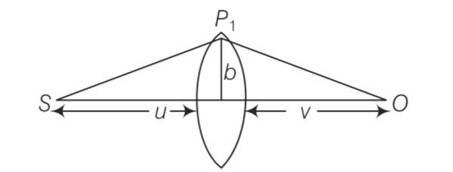(i) Consider a thin lens placed between a source (S) and an observer (O) (Figure). Let the thickness of the lens vary as w(b) =w0– b2/α , where b is the vertical distance from the pole, w0is a constant. Using Fermat’s principle, i.e., the time of transit fora ray between the source and observer is an extremum find the condition that all paraxial rays starting from the source will converge at a point O on the axis. Find the focal length.

(i) Consider a thin lens placed between a source (S) and an observer (O) (Figure). Let the thickness of the lens vary as w(b) =w0– b2/α , where b is the vertical distance from the pole, w0is a constant. Using Fermat’s principle, i.e., the time of transit fora ray between the source and observer is an extremum find the condition that all paraxial rays starting from the source will converge at a point O on the axis. Find the focal length.

-
1 Answer
-
This is a long answer type question as classified in NCERT Exemplar
Time from S to P1 is
t1 =
Time from P1 to O is
t2 = ;
the time required travel through lens is t1 =
so total time is t=1/c(u+v+b2/2D+(n-1)(wo+b2/ ))
after solving we get
differentiating with respect to time
t=1/c(u+v+b2/2D+(n-1)K1In(K2b))
dt/db=0=b/D-(n-1)K1/b
b2= (n-1)K1D
b=
Similar Questions for you
A total refractive prism is also known as a total internal reflection prism. It is an optical prism that is designed for reflecting 100% of the incident light. This happens since this prism uses the principle of total internal reflection. These prisms are oriented and shaped in a specific way so that the light that enters at a specific angle is completely reflected inside the prism. A right-angle prism, porro prism, dove prism and roof prism are some of the examples of total reflective prism.
Total deviation in a prism is the total angle by which the light ray gets bent as it passes through the prism. It is an angle between incident ray and emergent ray of the prism. When a light enters the prism, it will bend towards the normal. After that, it will travel through the prism and bend away from the normal as it exits. Total deviation is the sum of these two from which the apex angle is subtracted.
The formula for total deviation for a prism is as follows:
- : angle of incidence at first surface
- : angle of emergence at second surface
- A: apex angle of the prism
There are different types of glasses that are used in optical instruments, including the following:
Crown glass (K): This glass is used in eyeglasses, microscopes and cameras. It is used in prisms and windows in optical systems. Crown glass has a low refractive index, low dispersion and excellent transparency in visible spectrum.
Flint Glass (F): This glass, when combined with crown glass, can correct chromatic aberration in lenses. They are also used in prisms for spectroscopy.
Extra-low dispersion glass: These glasses are used in premium optics that are also used for making high-quality camera lenses, telescopes and binoculars.
Optical instruments can have some of the following defects that may impact their performance, which have arisen due to design limitations, manufacturing and physical properties of light:
- Chromatic Aberration: This defect occurs because of the different wavelengths of light that refract at slightly different angles when they pass through the lens. It causes them to focus on different points.
- Spherical Aberration: This happens because light rays pass through the edges of spherical lens or reflect off spherical mirror focus at different point than rays that pass through the center.
- Astigmatism: This type of defect occurs due to the uneven cu
Yes, optical instruments are used in modern medicine for many purposes including surgery, monitoring, research and diagnosis. Let us take a look at each one by one:
- Many optical instruments are used for visualizing internal structures for diagnosis of a disease and its monitoring. These include Ophthalmoscope, Endoscope, Colposcope and Dermatoscope.
- Optical instruments are also used for precision and minimally invasive surgeries, including Laparoscope, Arthroscope and Surgical Microscopes.
- Lasers are used for cutting, therapy and coagulation since they have precision and minimal invasiveness. CO? Laser, Excimer Laser and Fiber Optic
Taking an Exam? Selecting a College?
Get authentic answers from experts, students and alumni that you won't find anywhere else
Sign Up on ShikshaOn Shiksha, get access to
- 66k Colleges
- 1.2k Exams
- 680k Reviews
- 1800k Answers
